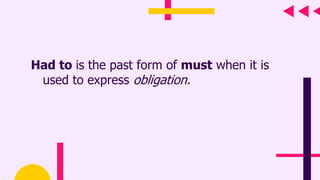MODALS_Eng9
- 2. What are Modal Verbs? - Helping verbs used together with base form of main verbs
- 4. Modal Verbs are special verbs which behave very differently from ordinary verbs. Here are some important differences:
- 5. 1. They have no -s in the third person singular (he, she, it). Example: She shoulds pass the entrance test before enrolment period.
- 6. 1. They have no -s in the third person singular (he, she, it). Example: She shoulds pass the entrance test before enrolment period. Correct Sentence: She should pass the entrance test before enrolment period.
- 7. 2. Most modal verbs, except for ought, are followed by the verb without to. Example: Gallaudet should to build a new computer center.
- 8. 2. Most modal verbs, except for ought, are followed by the verb without to. Example: Gallaudet should to build a new computer center. Correct Sentence: Gallaudet should build a new computer center.
- 9. 3. Modals have no infinitive or –ing form. Example: My parents can singing well.
- 10. 3. Modals have no infinitive or –ing form. Example: My parents can singing well. Correct Sentence: My parents can sing well.
- 11. 6. Questions can be made by placing the modal verb before the subject and without using do/did. Example: May I see what you’ve been playing on your phone?
- 12. Let’s practice!
- 13. Which sentence has a modal verb?
- 14. 1.Do not turn on that computer, it is not working properly. We should fix it first. 2.We have been arguing over this issue for half an hour, let’s change the topic. 3.Let’s visit our grandpa, we have not seen him since Christmas
- 17. Please choose the correct negative form of modal verb.
- 18. 1.I don’t can do it now, I am very busy until 5pm. 2.You must don’t smoke here, this is a no smoking zone. 3.He should not procrastinate his assignments, he may not get good grades.
- 22. Ability
- 23. 1. I can speak Chinese, but I can't write it. 2. She could swim for miles when she was younger. 3. Can/Could you close the window, please? (request)
- 24. Permission
- 25. 1. Can/May I have another piece of cake, Dad? (request) 2. I'm afraid you can't leave until you've finished that work. 3. Might I have a word with you?
- 26. Can is commonly used to ask for or give permission. May is more formal. Could and might are used to ask for (not to give) permission. They are more tentative than can.
- 27. Possibility
- 28. 1. She may/might (not) go to Paris tomorrow. 2. Don't touch that wire. It could be dangerous. 3. Where can/could they be after the class dismissal?
- 29. Certainty
- 30. 1. Joe must be at least 25 to get the job. 2. He must have graduated years ago. 3. We can't have been at college together. I'm sure we weren't at college together.
- 32. 1. I must phone my parents tonight before attending the party. 2. You must not smoke in the cinema. 3. He had to leave early for the final rehearsal.
- 33. Had to is the past form of must when it is used to express obligation.
- 34. Probability
- 35. 1. Their meeting should/ought to be over now. (I expect it is!) 2. They should have/ought to have received our letter by now.
- 36. Let’s practice!
- 37. Identify the modal verb and modality (definition) in the following sentences.
- 38. 1. You could play with your PS4 after school, but you must finish your homework first.
- 39. 1. You could play with your PS4 after school, but you must finish your homework first.
- 40. 2. Since all dogs are mammals, this golden retriever must be a mammal.
- 41. 2. Since all dogs are mammals, this golden retriever must be a mammal.
- 42. 3. You might consider finishing your household chores before playing computer games.
- 43. 3. You might consider finishing your household chores before playing computer games.
- 44. 4. I will finish my essay tonight even if I have to forgo sleep.
- 45. 4. I will finish my essay tonight even if I have to forgo sleep.
- 46. 5. The puppy can sit on command.
- 47. 5. The puppy can sit on command.
- 48. 6. I would eat cereal every day as a child.
- 49. 6. I would eat cereal every day as a child.
- 50. 7. You may encounter some difficult players on occasion.
- 51. 7. You may encounter some difficult players on occasion.
- 52. 8. The train should arrive in a few minutes. I better be going.
- 53. 8. The train should arrive in a few minutes. I better be going.
- 54. 9. The situation would not be so bad if we all remained calm.
- 55. 9. The situation would not be so bad if we all remained calm.
- 56. 10. I will have earned my graduate degree next semester.
- 57. 10. I will have earned my graduate degree next semester.
- 58. Quiz time!
- 59. You are amazing!


























































